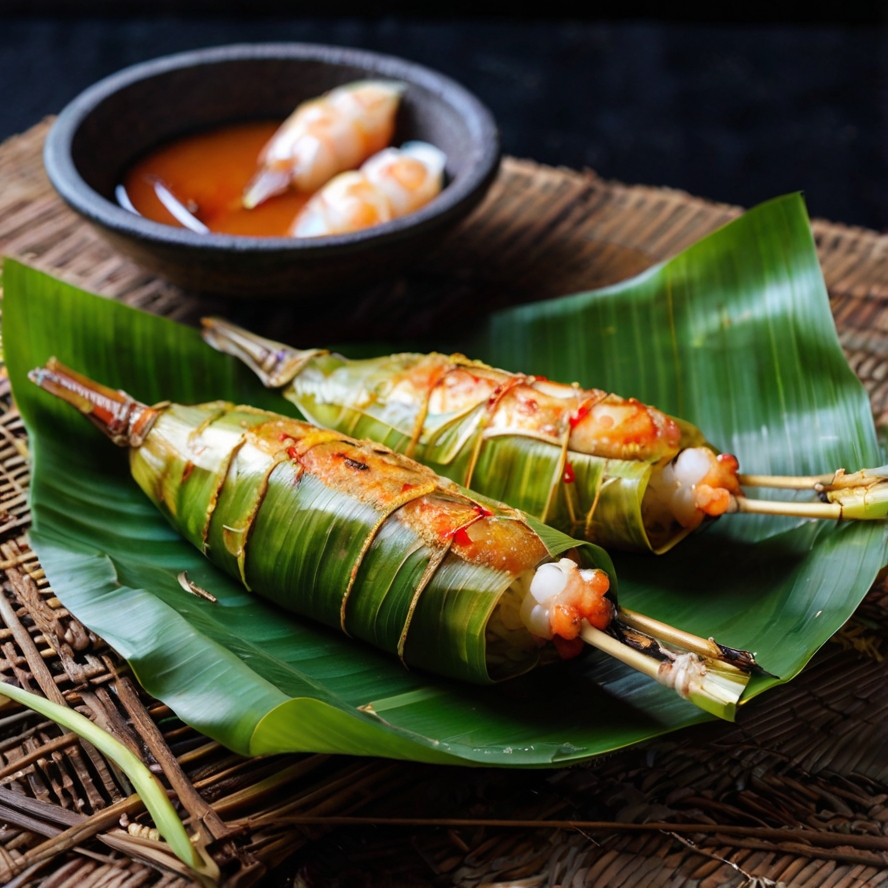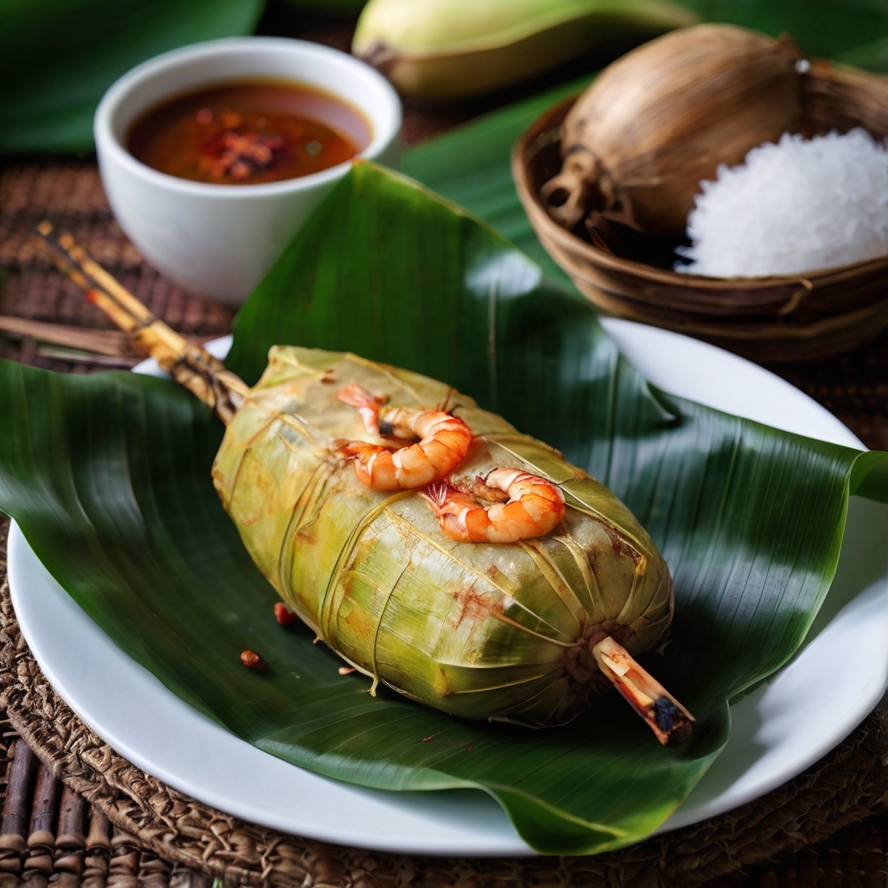Pulut Panggang is a popular Malaysian dish that provides a unique blend of flavors, offering both nutritional benefits and potential concerns. Rich in carbohydrates from the glutinous rice, it serves as an excellent energy source, while the spiced coconut or prawns provide a good source of protein and healthy fats. The banana leaf wrapping not only enhances the aroma but also adds a slight earthy flavor. As with any dish, it's important to consume Pulut Panggang in moderation. While it offers beneficial vitamins such as vitamin C from the coconut and vitamin B12 from the prawns, it can be calorie-dense due to the glutinous rice and coconut filling. Overall, this dish can be a part of a balanced diet when enjoyed occasionally.
Ingredients:
- 2 cups glutinous rice
- 1 cup coconut milk
- 1/2 cup grated coconut
- 1 tablespoon sugar
- 1 teaspoon salt
- 10-12 medium-sized prawns (optional)
- 1/2 teaspoon turmeric powder
- 10 banana leaves (for wrapping)
Ingredient Substitutions:
If you don’t have access to certain ingredients, here are some alternatives you can use:
- Coconut Milk: If you’re looking for a lighter version, use low-fat coconut milk or a plant-based alternative such as almond milk or soy milk. These will reduce the fat content while still providing a creamy texture.
- Prawns: If you're not a fan of seafood or prefer a vegetarian version, you can replace prawns with chicken or tofu. For a plant-based option, chickpeas or lentils can provide a good protein substitute.
- Sugar: You can use honey or maple syrup as a more natural alternative to sugar, adjusting the quantity based on your sweetness preference.
Preparation Method for Pulut Panggang
Soak the glutinous rice:
- Begin by soaking the glutinous rice in a large bowl of water for 4 to 6 hours. This helps to soften the rice, allowing it to cook evenly. After the soaking period, drain the rice thoroughly to remove excess water.
Steam the rice:
- Set up a steamer and add the drained rice. Steam the rice for about 30 minutes, or until it becomes fully cooked and tender. Stir occasionally to ensure even cooking. The rice should be sticky but not mushy once done.
Prepare the coconut mixture:
- While the rice is steaming, heat a pan over medium heat. Pour in the coconut milk and add the grated coconut, sugar, and salt. Stir the mixture continuously, ensuring the sugar dissolves completely and the coconut is evenly distributed in the coconut milk. Continue to cook for about 5 minutes, allowing the flavors to combine. Set the mixture aside.
Cook the prawns (optional):
- If you're using prawns, peel and devein them. In a separate pan, cook the prawns with turmeric powder and a pinch of salt over medium heat. Stir frequently, cooking until the prawns turn pink and are fully cooked. Once done, set them aside to cool slightly, then chop them into smaller pieces.
Combine the rice and coconut mixture:
- Once the rice is cooked, transfer it to a large mixing bowl. Pour in the coconut milk mixture and stir until the rice is thoroughly coated with the coconut mixture. If you are using prawns, add the chopped prawns to the rice and mix well to distribute them evenly throughout.
Prepare the banana leaves:
- Cut the banana leaves into rectangular pieces, large enough to wrap the rice mixture. Briefly grill or steam the banana leaves to soften them. This will make them more pliable and easier to work with when wrapping the rice.
Wrap the rice in banana leaves:
- Spoon a generous amount of the rice mixture onto each banana leaf piece. Carefully fold the leaf over the rice to form a neat parcel. If necessary, fold the edges to secure the parcel. Repeat this process until all the rice mixture is wrapped.
Grill the parcels:
- Preheat a grill to medium heat. Place the wrapped parcels on the grill, making sure they are not touching each other. Grill the parcels for about 10-15 minutes, turning them occasionally, until they develop a slight char and a fragrant aroma from the banana leaves.
Serve:
- Once the Pulut Panggang parcels are grilled to perfection, remove them from the grill. Allow them to cool slightly before serving. Enjoy the flavorful, aromatic dish hot, as a snack or side dish.
This method ensures that each parcel of Pulut Panggang is perfectly cooked with the right balance of textures, flavors, and aromas, making for a delicious Malaysian treat.
Ideas for Serving Pulut Panggang:
- Pulut Panggang is a versatile dish that can be served in a variety of ways. While it’s delicious on its own, it can also be paired with other traditional Malaysian dishes for a more elaborate meal. Consider serving it alongside satay (grilled skewers of meat), nasi lemak (coconut rice), or a refreshing cucumber salad for a balanced and flavorful spread.
Additionally, pairing Pulut Panggang with beverages such as teh tarik (Malaysian milk tea) or a fresh coconut drink enhances the experience. The combination of flavors in the drink complements the rich, earthy taste of the dish.
Additional Tips to Enhance Flavor:
To elevate the flavor of Pulut Panggang, there are a few tips you can follow:
- Reduce Fat Content: To make the dish lighter, you can substitute full-fat coconut milk with low-fat coconut milk or even almond milk. This will reduce the calorie and fat content while still providing some coconut flavor.
- Add More Spices: For those who prefer more complexity in their flavors, you can experiment by adding spices like cinnamon or cloves to the coconut mixture. A pinch of cumin or coriander can also enhance the overall taste.
- Adjust Sweetness: If you prefer a less sweet flavor, reduce the sugar content slightly. The natural sweetness from the coconut milk and grated coconut is usually enough for a balanced flavor.
Tips for Beginners:
If you are new to making Pulut Panggang, here are a few tips to help you avoid common mistakes:
- Handling Banana Leaves: Banana leaves need to be softened before they can be used for wrapping. The easiest way to do this is by briefly grilling them over a low flame or steaming them for a few seconds. This makes them more pliable and prevents them from breaking when wrapping the rice.
- Steaming the Rice: Make sure the rice is steamed for long enough. If the rice is undercooked, it may become hard and difficult to form into neat parcels. Ensure the water in the steamer is boiling, and the rice should be sticky yet firm.
- Securing the Parcel: When wrapping the rice in the banana leaves, be sure to fold the leaves tightly and securely to prevent the filling from spilling out while grilling. You can use toothpicks to secure the ends if necessary.
Frequently Asked Questions (FAQs):
What is the best way to choose banana leaves?
- To select the best banana leaves, look for leaves that are fresh, vibrant green, and free of tears or holes. Avoid using leaves that are yellowing or overly dry. If you can’t find fresh leaves, you can also use frozen banana leaves, which are widely available in Asian grocery stores. Always wash and soften them before use.
Can Pulut Panggang be prepared ahead of time and stored?
- Yes, Pulut Panggang can be made ahead of time. After grilling, allow the parcels to cool completely. Store them in an airtight container in the refrigerator for up to 2 days. To reheat, simply grill the parcels again for a few minutes to restore their flavor and texture.
What are some good substitutes for prawns?
If you prefer not to use prawns, there are several options you can try:
- Chicken: Thinly sliced or minced chicken can be a great alternative.
- Tofu: For a vegetarian option, tofu can replace prawns, providing a soft texture and a good protein source.
- Lentils: Cooked lentils or chickpeas can provide plant-based protein and are a great meat alternative.
How can I make Pulut Panggang healthier?
To make Pulut Panggang lighter and healthier, consider these adjustments:
- Use low-fat coconut milk instead of full-fat coconut milk.
- Reduce the amount of sugar used, as coconut milk already provides a slight sweetness.
- Consider grilling the parcels for a shorter time to avoid excess charring, which can add unnecessary fats.
Is Pulut Panggang suitable for children?
- Yes, Pulut Panggang can be suitable for children, especially if you make adjustments to suit their tastes. For example, you can reduce the spice level or replace the prawns with chicken or tofu. Be mindful of the salt content, as too much salt can be unhealthy for children.
Can I add vegetables or other spices to Pulut Panggang?
- Absolutely! You can add vegetables like carrots, bell peppers, or peas to the rice mixture for added color, texture, and nutritional value. Spices like coriander or cumin can also be included to enhance the flavor, giving a new twist to this traditional dish.

Nutritional values and benefits
Glutinous Rice (2 cups)
- Calories: 370
- Carbohydrates: 80g
- Protein: 6g
- Fat: 1g
- Vitamins:
- Vitamin B6: 0.1mg (5% DV)
Nutritional Benefit: Glutinous rice provides a quick source of energy due to its high carbohydrate content and supports overall health with vitamin B6, which plays a role in metabolism and the production of red blood cells.
Coconut Milk (1 cup)
- Calories: 445
- Carbohydrates: 6g
- Protein: 5g
- Fat: 48g
- Vitamins:
- Vitamin C: 5mg (8% DV)
- Vitamin E: 1.2mg (8% DV)
Nutritional Benefit: Coconut milk is rich in healthy fats, which support heart health. It also contains vitamin C, important for immunity, and vitamin E, which promotes skin health and works as an antioxidant.
Grated Coconut (1/2 cup)
- Calories: 200
- Carbohydrates: 8g
- Protein: 2g
- Fat: 18g
- Vitamins:
- Vitamin C: 2mg (3% DV)
Nutritional Benefit: Grated coconut adds a significant amount of healthy fats and dietary fiber, which helps digestion and supports heart health by reducing cholesterol levels.
Sugar (1 tablespoon)
- Calories: 50
- Carbohydrates: 13g
- Protein: 0g
- Fat: 0g
Nutritional Benefit: Sugar adds sweetness but contributes empty calories. It provides a quick energy boost but should be consumed in moderation to avoid spikes in blood sugar levels.
Salt (1 teaspoon)
- Sodium: 2300mg (100% DV)
Nutritional Benefit: Salt is essential for maintaining fluid balance and proper nerve function. However, excessive salt intake should be avoided as it can lead to high blood pressure.
Prawns (10-12 medium-sized, optional)
- Calories: 100
- Carbohydrates: 1g
- Protein: 20g
- Fat: 1g
- Vitamins:
- Vitamin B12: 1.5mcg (25% DV)
- Selenium: 34mcg (60% DV)
Nutritional Benefit: Prawns are a great source of lean protein and contain important nutrients like vitamin B12, which is crucial for brain and nerve health, and selenium, which supports immune function and acts as an antioxidant.
Turmeric Powder (1/2 teaspoon)
- Calories: 4
- Carbohydrates: 1g
- Protein: 0g
- Fat: 0g
- Vitamins:
- Vitamin C: 0.5mg (1% DV)
Nutritional Benefit: Turmeric contains curcumin, a powerful anti-inflammatory compound that helps reduce inflammation and supports joint health. It also has antioxidant properties.
Banana Leaves (for wrapping)
Nutritional Benefit: While not directly consumed, banana leaves are rich in antioxidants, essential oils, and phytonutrients that can contribute to flavor and health benefits. They also impart a unique aroma and help retain the dish's nutrients during cooking.
By combining these ingredients, Pulut Panggang offers a balanced and flavorful dish that provides energy, supports immune health, promotes digestion, and contributes to overall well-being. The dish is a perfect combination of healthy fats, lean protein, and vitamins.


Comments